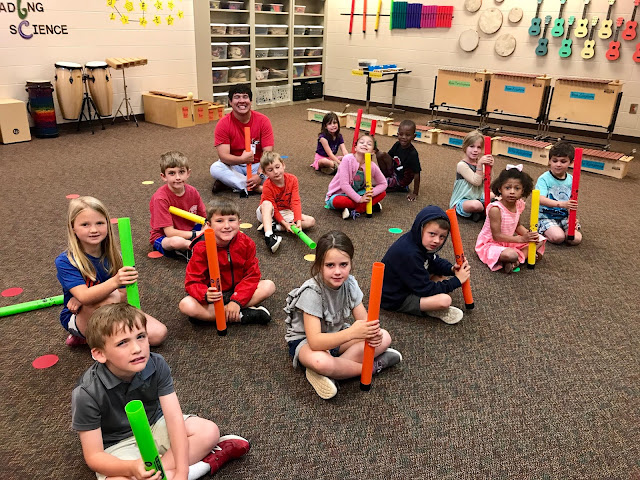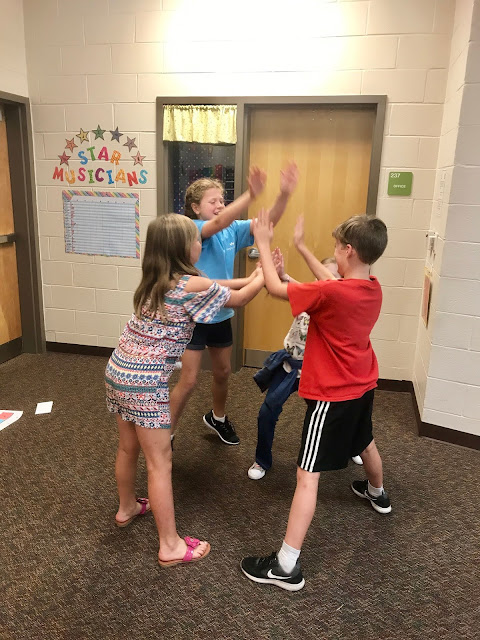We have really been enjoying our free Quaver trial this semester! Today in Kindergarten, we celebrated Earth Day by learning the song "Save the Planet." Then, we added a quick, easy, and fun accompaniment with Boomwhackers.
We discussed some of the different ways that they could take care of the planet. Some of their ideas were pick up trash, don't litter, plant a tree, and reuse our things. Each student wrote their idea on the provided worksheet and enjoyed coloring the sheet as well.
At the end of class, the students took turns singing their ideas as a "solo" in the song.
Here's the worksheet for anyone interested! :)
♫ We ❤ Music @ HSES! ♫
Welcome to the HSES Music Room Blog! We hope you check in with us often to find out what our marvelous musicians are learning!
Monday, April 22, 2019
Thursday, March 7, 2019
Composer of the Month
Third, fourth, and fifth grade students really enjoy our month composer studies! The first week of our study, we read a biography about the famous composer and discuss facts about their life. In the following weeks, we listen to and learn about the most famous and important pieces by the composer. Many times, I show the students a video of the piece being performed but my favorite way to introduce a piece is to show a listening map. Our most recent study was about Beethoven. Here are a few of the listening maps that my students enjoyed watching throughout our study.
At the end of our study, we usually play a game to review the information they've learned about the composer. Their favorite game is Kahoot! and they beg me to play it all the time. :) After we play Kahoot, I usually have another computer game or activity for them to do related to that composer. Since we studied about Beethoven this month, they enjoyed playing with the Beethoven Google Doodle where students had to help Beethoven get to the symphony concert by putting his music in the right order. It was a great way to reinforce identifying the most famous Beethoven melodies!
Monday, January 21, 2019
Sixteenth Note Practice!
Third graders at HSES have been reviewing notes and rests. We reviewed the rhythms we learned earlier in the year and just added in sixteenth notes. I've recently gotten a trial of Quaver to use in my classroom and so I looked to see what was available for teaching sixteenth notes. Quaver's "Sixteenth Note Samba" is SO catchy and my students LOVED it.
Also, I don't think I've ever had a group of students catch on so quickly to counting sixteenths. :) Here they are working with partners to create, notate, and perform rhythms with sixteenth notes.
Also, I don't think I've ever had a group of students catch on so quickly to counting sixteenths. :) Here they are working with partners to create, notate, and perform rhythms with sixteenth notes.
Thursday, September 6, 2018
Rules and Rhythms - Updated!
Rules and Rhythms has become my favorite back-to-school lesson! It is the perfect way to review our music rules and expectations while also practicing rhythms and having fun! This year, I tweaked the lesson a little and the students did a great job and seemed to really enjoy it.
First, each group was given one of our music rules and they had to notate the rhythm using their rhythm cards.
Next, the groups were asked to create a body percussion pattern to perform their rhythm. They used creative combinations of snapping, patting, stomping, clapping, and more. After some practice, each group performed their body percussion and rule for the class to a beat track. This is the track we used and it worked really well: https://www.youtube.com/watch?v=anCq5XLnnKY
Finally, we had each group perform their body percussion at the same time while saying their rule out loud (using the beat track). So much fun! Now, the students know our music rules and they are ready for our rhythm unit!
First, each group was given one of our music rules and they had to notate the rhythm using their rhythm cards.
Finally, we had each group perform their body percussion at the same time while saying their rule out loud (using the beat track). So much fun! Now, the students know our music rules and they are ready for our rhythm unit!
Monday, February 19, 2018
Instrument Aikendrum
Kindergarten students have been learning all about our classroom percussion instruments. They've learned to identify the instrument names and play them using correct technique. I got the idea from Mrs. Mattson's Music Room to use this "Aikendrum" activity to review all that they've learned. First, I introduced the song and we talked about what they heard. The students loved hearing all of the silly things Aikendrum was made from.
Next, we learned the song and sang it together. I used Raffi's version.
Then, I had a few students come to the board to choose their own Aikendrum food items and we sang the song again.
Here is a copy of the worksheet I made for those interested. Enjoy!
Next, we learned the song and sang it together. I used Raffi's version.
Then, I had a few students come to the board to choose their own Aikendrum food items and we sang the song again.
After some fun singing together, I told the students that they were going to get to be even more creative together and create an Aikendrum from our classroom percussion instruments. I put them into groups, gave them a bucket of instruments, and the fun began. Once they were finished creating their Aikendrum, they worked together to draw a picture of each instrument part and write the instrument's name in the blank for their creation. They also tried to sing their own version of the song.
Here are a few pictures of what they came up with:
Friday, February 9, 2018
Treble Clef Practice with Boomwhackers
Fourth and Fifth grader music classes have been learning about and reviewing the treble clef staff. They've been playing games to practice identifying the names of the lines and spaces. Before we begin playing soprano recorders, I wanted to give them a little more practice with reading a melody on the treble clef. I set up 5 stations around the room with a variety of children's melodies (Twinkle Twinkle, Old MacDonald, etc.) and but a set of Boomwhackers at each station. When the students arrived at a station, they were to divvy out the Boomwhackers and review which note they had an where it was located on the staff. Then, they worked together to play the notes in order to create the melody. Each group typically had time to play through each melody about 4 times before they had to rotate to the next station. This took concentration and team work!
Thursday, November 16, 2017
Woods, Metals, and Skins - Oh My!
Our Kindergarten students have been learning all about the classroom percussion instruments. They've learned their names and how to play them with correct technique. Recently, they learned that we can categorize these instruments into 3 groups: Woods, Metals, and Skins.
Finally, I have the students work in groups to create their own maps. They take turns creating their line with a piece of yarn and then place the shapes (cut out on the die-cut machine) wherever they want. The student who created the map gets to be the pointer while the other students play. The students really enjoyed this and I loved seeing all of their creativity. It also gave me a chance to work one-on-one with any students who were still struggling with technique or playing on cue. Here are a few pictures of them hard at work in their groups:
After learning to categorize the instruments, I show the students how we can use a shape to represent each group. I pass out the instruments and they have to group themselves according to their instrument and shape.
Next, I show the students these Aleatoric Maps, created by my friend Charlotte, and they play their instrument as I trace the line. You can also trace from each end point as well as point slower or faster. We do several of these together and then I have a few students come to the board to make one collaboratively.
Subscribe to:
Comments (Atom)
















































